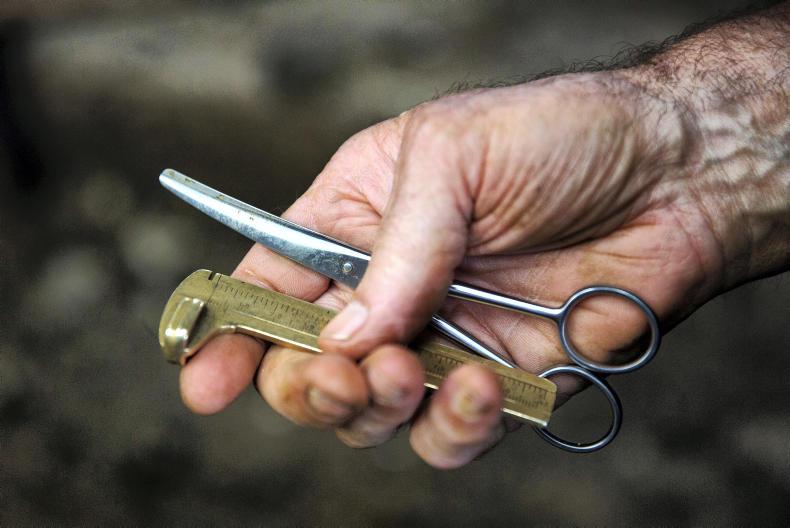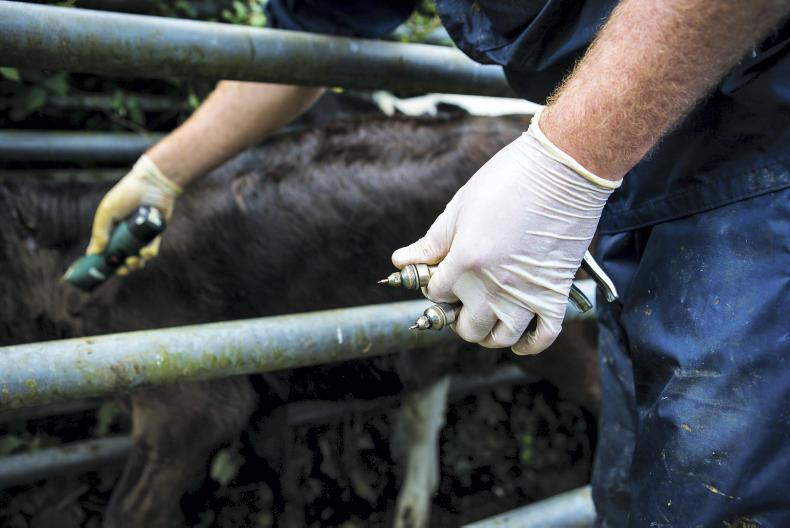The TB Forum has recommended 10 actions to Minister for Agriculture Michael Creed to eradicate TB by 2030.
Among the recommendations are better communication with farmers on TB, incentivisation for biosecurity measures, reducing the TB risk from badgers and enhanced supports for herds with a chronic TB history.
1. Incentivise farmers to implement biosecurity measures
The TB Forum recommends that farmers be provided with biosecurity advice on how to reduce the risk to cattle of bovine TB in a range of ways, including leaflets, websites, videos, etc.
This would include detailed biosecurity advice on how to reduce the potential risk posed by introducing new cattle to the herd, contact between cattle and potentially TB-infected wildlife and highlighting the importance of good disinfection.
The TB Forum recommended that farmers be incentivised to implement these measures.
Would this measure eradicate TB by 2030? According to the TB Forum, implementing this measures would have a moderate impact on TB eradication and would be “unlikely to change behaviour sufficiently to significantly reduce the level of TB”.
2. Single point of contact and communications
The Department should put in place a single point of contact for farmers affected by TB breakdowns, with the aim of reducing the stress and uncertainty which farmers endure, particularly in the early days of a restriction, according to the TB Forum.
This contact would be a person in the Department’s regional offices and would advise farmers on the process, the options and steps involved.
Would this measure eradicate TB by 2030? The TB Forum said that this measure would have minor impact in eradicating TB, but was very important due to the potential impact on reducing farmer stress.
3. Blackspot action plans
In areas of the country which are considered TB blackspots, the report recommends that “management of these should be based on the area affected in order to ensure consistency of approach, maximise effectiveness and immediate access to all relevant material for those affected”.
A blackspot action plan should include: a methodology to identify blackspots based on disease levels and spatial clustering, and thorough investigations of the drivers of the increase in disease and of all TB breakdowns in the area.
When it comes to blackspot areas, it is recommended that local meetings should take place between the Department and stakeholders.
Would this measure eradicate TB by 2030? The implementation of this measures would be moderate, according to the report.

4. Reducing the risk posed by badgers
The forum recommends that the Department continues and enhances its focus on the risk posed by badgers, with sufficient resources committed to the wildlife programme to optimise its implementation.
It also recommends that the Department expedites the investigation into the Monaghan/Cavan blackspot area and considers implementing a pen-side TB test for badgers if it passes DAFMs field-testing phase.
Would this measure eradicate TB by 2030? This measure would be significant in eradicating TB by 2030, according to the forum. “This policy can reduce the level of transmission of TB from badgers to cattle sufficiently to enable a focus on reducing cattle-to-cattle transmission to have a real impact,” the report said.
5. Reducing the risk posed by deer
The TB Forum proposes a policy of reducing deer density throughout the country, combined with a deer population reduction programme near TB outbreaks.
“Deer should not be allowed to become a maintenance host for TB. DAFM will communicate to farmers the methods by which they can reduce the potential risk posed by deer to their herds. DAFM will also engage with Coillte regarding deer on Coillte lands,” according to the report.
Would this measure eradicate TB by 2030? Implementing this measure would be limited in eradicating TB, the report said. “Since there is no evidence that deer play a significant role in propagating bTB in cattle in most of the country, it follows that culling deer in those areas is unlikely to influence cattle TB levels,” it said.

6. Enhanced support for herds with chronic TB history
Herds which are currently not restricted but which have a chronic history of severe TB or a pattern of repeated breakdowns are at a much higher risk of future breakdowns.
“By intervening with enhanced support to reduce disease risk more effectively in these herds, it would be possible to better protect them. This will help by reducing their risk of future breakdowns and reducing the severity of any breakdown which did occur, while also increasing the protection delivered to neighbouring herds, herds which might trade with these chronic herds, and the 97% of herds which are TB free,” it said.
The forum said such herds could be termed “enhanced support herds” and would be defined by the number of reactors, number of episodes of TB and the length of breakdown episodes. The Department is to define the exact criteria for a herd to be termed as an “enhanced support herd”.
It is estimated that up to 500 herds would fit into this category.
These herds should receive a tailored TB risk management plan and where there is a chronic ongoing problem, depopulation should be considered when other measures fail.
It was also recommended that the Department would pay for pre-movement tests up to four times a year for these herds, if required.
Before derestriction is carried out, all measures necessary must be implemented, and any such measures much be supported by scientific research, the report said.
Would this measure eradicate TB by 2030? If these measures were implemented, it would have a significant impact on eradicating TB by 2030.

7. Risk-based categorisation of herds
The TB Forum discussed the proposal of developing revised TB herd risk categories which are simple, clear and convey sufficient information to enable farmers to make the decisions appropriate to their situation.
Three options were discussed, with the preferred option, subject to further consideration of the final details between farm organisations and the Department, outlined below:
Calendar years combined with qualitative assessment of risk: This status combines a number (one-10) indicating the number of years since the herd was last bTB restricted, capped at 10. This means that a herd that has been clear for three years would be designated as C3; a herd that has been clear for 10 years or more would be designated as C10.
Would this measure eradicate TB by 2030? “This would be an important and necessary support to other policies; without an effective risk-categorisation system, risk-based TB controls cannot be implemented as effectively,” the report said.
8. Helping farmers to better understand their own TB risk
Enabling farmers to know their own TB risk and to understand what that means and how they can make decisions based on that would be a critical part of supporting farmers, it recommends.
The mechanism for this could be printing the risk category on TB-related correspondence (as is currently done using the present risk category system), combined with a website enabling farmers to look up their own risk, it said.
Would this measure eradicate TB by 2030? This would be a critical part of enabling farmers to make decisions to manage their own TB risk, the report said.
9. Incentivised removal of cattle with inconclusive tests
“Cattle which have in the past tested inconclusive and re-tested negative are at a much higher risk of developing TB and spreading the disease.
“Farmers should be made aware of the risks associated with inconclusive animals and strongly advised to voluntarily slaughter these animals,” the TB Forum advised.
In order to eliminate inconclusive cattle that could potentially be infected, the Department will blood-test all inconclusives that pass a skin re-test, and then blood-test them again at regular intervals if still retained in the herd, the report said.
Would this measure eradicate TB by 2030? This measure would have a moderate impact on TB eradication and would reduce residual spread of the disease within the herd.

10. Impact
The TB Forum said there was general consensus that the current TB eradication programme is not sufficient enough to eradicate TB by 2030, nor even to reduce TB levels significantly below the current levels of around 3.5% herd incidence annually.
“If the goal of TB eradication by 2030 is to be achieved, substantially more-effective policies are needed, in addition to the existing policies,” it said.
Read more
European 30-day pre-movement test rule to cost €20m/year – IFA
500 cattle herds targeted in TB report
Potential TB vaccination breakthrough for cattle
The TB Forum has recommended 10 actions to Minister for Agriculture Michael Creed to eradicate TB by 2030.
Among the recommendations are better communication with farmers on TB, incentivisation for biosecurity measures, reducing the TB risk from badgers and enhanced supports for herds with a chronic TB history.
1. Incentivise farmers to implement biosecurity measures
The TB Forum recommends that farmers be provided with biosecurity advice on how to reduce the risk to cattle of bovine TB in a range of ways, including leaflets, websites, videos, etc.
This would include detailed biosecurity advice on how to reduce the potential risk posed by introducing new cattle to the herd, contact between cattle and potentially TB-infected wildlife and highlighting the importance of good disinfection.
The TB Forum recommended that farmers be incentivised to implement these measures.
Would this measure eradicate TB by 2030? According to the TB Forum, implementing this measures would have a moderate impact on TB eradication and would be “unlikely to change behaviour sufficiently to significantly reduce the level of TB”.
2. Single point of contact and communications
The Department should put in place a single point of contact for farmers affected by TB breakdowns, with the aim of reducing the stress and uncertainty which farmers endure, particularly in the early days of a restriction, according to the TB Forum.
This contact would be a person in the Department’s regional offices and would advise farmers on the process, the options and steps involved.
Would this measure eradicate TB by 2030? The TB Forum said that this measure would have minor impact in eradicating TB, but was very important due to the potential impact on reducing farmer stress.
3. Blackspot action plans
In areas of the country which are considered TB blackspots, the report recommends that “management of these should be based on the area affected in order to ensure consistency of approach, maximise effectiveness and immediate access to all relevant material for those affected”.
A blackspot action plan should include: a methodology to identify blackspots based on disease levels and spatial clustering, and thorough investigations of the drivers of the increase in disease and of all TB breakdowns in the area.
When it comes to blackspot areas, it is recommended that local meetings should take place between the Department and stakeholders.
Would this measure eradicate TB by 2030? The implementation of this measures would be moderate, according to the report.

4. Reducing the risk posed by badgers
The forum recommends that the Department continues and enhances its focus on the risk posed by badgers, with sufficient resources committed to the wildlife programme to optimise its implementation.
It also recommends that the Department expedites the investigation into the Monaghan/Cavan blackspot area and considers implementing a pen-side TB test for badgers if it passes DAFMs field-testing phase.
Would this measure eradicate TB by 2030? This measure would be significant in eradicating TB by 2030, according to the forum. “This policy can reduce the level of transmission of TB from badgers to cattle sufficiently to enable a focus on reducing cattle-to-cattle transmission to have a real impact,” the report said.
5. Reducing the risk posed by deer
The TB Forum proposes a policy of reducing deer density throughout the country, combined with a deer population reduction programme near TB outbreaks.
“Deer should not be allowed to become a maintenance host for TB. DAFM will communicate to farmers the methods by which they can reduce the potential risk posed by deer to their herds. DAFM will also engage with Coillte regarding deer on Coillte lands,” according to the report.
Would this measure eradicate TB by 2030? Implementing this measure would be limited in eradicating TB, the report said. “Since there is no evidence that deer play a significant role in propagating bTB in cattle in most of the country, it follows that culling deer in those areas is unlikely to influence cattle TB levels,” it said.

6. Enhanced support for herds with chronic TB history
Herds which are currently not restricted but which have a chronic history of severe TB or a pattern of repeated breakdowns are at a much higher risk of future breakdowns.
“By intervening with enhanced support to reduce disease risk more effectively in these herds, it would be possible to better protect them. This will help by reducing their risk of future breakdowns and reducing the severity of any breakdown which did occur, while also increasing the protection delivered to neighbouring herds, herds which might trade with these chronic herds, and the 97% of herds which are TB free,” it said.
The forum said such herds could be termed “enhanced support herds” and would be defined by the number of reactors, number of episodes of TB and the length of breakdown episodes. The Department is to define the exact criteria for a herd to be termed as an “enhanced support herd”.
It is estimated that up to 500 herds would fit into this category.
These herds should receive a tailored TB risk management plan and where there is a chronic ongoing problem, depopulation should be considered when other measures fail.
It was also recommended that the Department would pay for pre-movement tests up to four times a year for these herds, if required.
Before derestriction is carried out, all measures necessary must be implemented, and any such measures much be supported by scientific research, the report said.
Would this measure eradicate TB by 2030? If these measures were implemented, it would have a significant impact on eradicating TB by 2030.

7. Risk-based categorisation of herds
The TB Forum discussed the proposal of developing revised TB herd risk categories which are simple, clear and convey sufficient information to enable farmers to make the decisions appropriate to their situation.
Three options were discussed, with the preferred option, subject to further consideration of the final details between farm organisations and the Department, outlined below:
Calendar years combined with qualitative assessment of risk: This status combines a number (one-10) indicating the number of years since the herd was last bTB restricted, capped at 10. This means that a herd that has been clear for three years would be designated as C3; a herd that has been clear for 10 years or more would be designated as C10.
Would this measure eradicate TB by 2030? “This would be an important and necessary support to other policies; without an effective risk-categorisation system, risk-based TB controls cannot be implemented as effectively,” the report said.
8. Helping farmers to better understand their own TB risk
Enabling farmers to know their own TB risk and to understand what that means and how they can make decisions based on that would be a critical part of supporting farmers, it recommends.
The mechanism for this could be printing the risk category on TB-related correspondence (as is currently done using the present risk category system), combined with a website enabling farmers to look up their own risk, it said.
Would this measure eradicate TB by 2030? This would be a critical part of enabling farmers to make decisions to manage their own TB risk, the report said.
9. Incentivised removal of cattle with inconclusive tests
“Cattle which have in the past tested inconclusive and re-tested negative are at a much higher risk of developing TB and spreading the disease.
“Farmers should be made aware of the risks associated with inconclusive animals and strongly advised to voluntarily slaughter these animals,” the TB Forum advised.
In order to eliminate inconclusive cattle that could potentially be infected, the Department will blood-test all inconclusives that pass a skin re-test, and then blood-test them again at regular intervals if still retained in the herd, the report said.
Would this measure eradicate TB by 2030? This measure would have a moderate impact on TB eradication and would reduce residual spread of the disease within the herd.

10. Impact
The TB Forum said there was general consensus that the current TB eradication programme is not sufficient enough to eradicate TB by 2030, nor even to reduce TB levels significantly below the current levels of around 3.5% herd incidence annually.
“If the goal of TB eradication by 2030 is to be achieved, substantially more-effective policies are needed, in addition to the existing policies,” it said.
Read more
European 30-day pre-movement test rule to cost €20m/year – IFA
500 cattle herds targeted in TB report
Potential TB vaccination breakthrough for cattle










 This is a subscriber-only article
This is a subscriber-only article










SHARING OPTIONS: